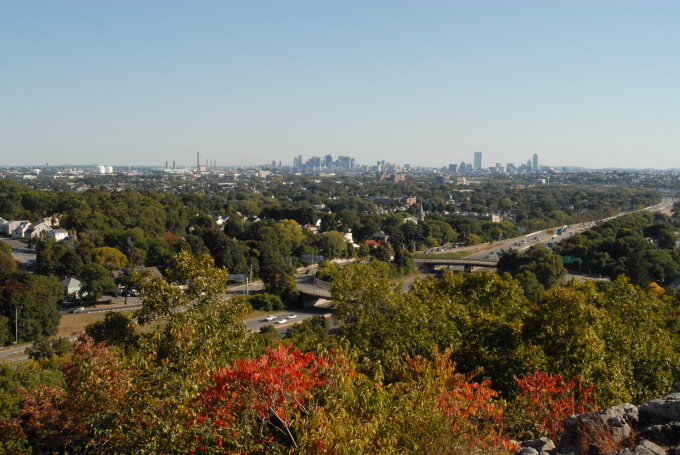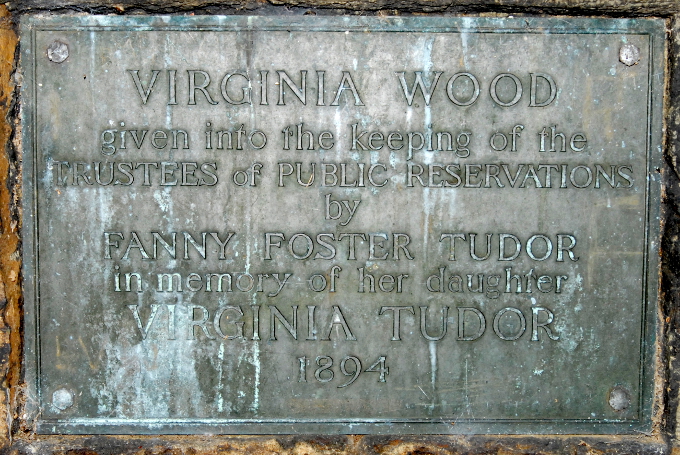The Middlesex Fells Reservation began in 1892 when Ms. Fannie Tudor donated the Viginia Woods to the Trustees of Reservations in memory of her daughter who had died in Paris. In 1893, At the urging of local resident Elizur Wright, landscape architect Charles Eliot and urban planner Sylvester Baxter the Massachusetts Legislature created the Metropolitan Park Commission (now part of DCR – the Department of Conservation and Recreation) which by 1900 had acquired 1,881 acres for the reservation.
Locally known as the ‘Fells’, the reservation now consists of 2,575 acres of upland, wetlands and open water.
Wetlands: The Fells are home to a number of ponds including Spot Pond (289.6 acres), the Middlesex Fells Reservoir (13.2 acres), Quarter Mile Pond (6.3 acres), Dark Hollow Pond (6.3 acres), Doleful Pond (5.7 acres) and Long Pond (4.1 acres). Twenty-six certified vernal pools and one-hundred-and-three potential vernal pools have been identified in the reservation.
Forest and Plants :The majority of forest is a mix of red and white oaks, white pine and hickory. Maple, ash, beech, birch. red pine, pitch pine, fir, spruce, and hemlocks make up a smaller forest component. A botanical survey completed in 2011 identified 564 native species of plants and 305 non-native species. The native species include three plants listed as endangered in Massachusetts; lesser snakeroot (not found in the last survey) , large-bracted tick-trefoil, and cankerweed. Additionally the following plants found at the Fells are considered rare; River birch, Maple-leaf goosefoot, Rose coreopsis, Keep’s hawthorn, Featherfoil, Violet bush-clover, Rock knotweed, Allegheny buttercup, Early buttercup, Cursed Crowfoot and Rock Spikemoss. The twenty-seven invasive species identified in the Fells are listed at the bottom of this article.
Wildlife: One hundred and eighty three species of birds have been recorded at the reservation. Twenty-seven of these are considered ‘In Greatest Need of Conservation’ including the Bald Eagle, the Common Loon and a variety of Hawks and Warblers. The Massachusetts Audubon Society has designated the Fells and Important Bird Area (IBA) for it’s importance as a migratory resting area. Twenty-one species of mammals have been confirmed at the reservation and others are thought to reside there. The confirmed list includes: Virginia Opposum, Eastern Gray Squirrel, Red Squirrel, Southern Flying Squirrel, Eastern Chipmunk, Woodchuck, American Beaver, Meadow Vole, Woodland Vole, White-footed Deermouse, Eastern Cottontail, Little Brown Myotis, Bobcat, Coyote, Gray Fox, Red Fox, Fisher, Long-tailed weasel, American Mink, Striped Skunk, Racoon and White-tailed Deer. Notably, local photographer George R. McLean photographed a Bobcat in the Winchester section of the reservation in 2008. Confirmed reptiles and amphibians include the Snapping Turtle, Northern Painted Turtle, North American Racer, Milksnake, Northern Watersnake, Eastern Ribbonsnake, Common Gartersnake, Spotted Salamander, Eastern Newt, Redback Salamander, American Toad, Spring Peeper, American Bullfrog, Green Frog, Pickerel Frog and the Wood Frog. It is worth noting that none of the snake species at the Fells are poisonous. Impressively, seventy-one species of butterflies and one-hundred-and-twenty-four species of moth have been identified at the Fells. Additionally, two rare tiger beetles (Hentz’s redbelly and purple tiger beetle) are present.
History: Prior to the arrival of Europeans, the Fells were occupied by Native Americans. Four pre-historic artifacts and three Native American tool workshops have been identified. Native Americans used volcanic outcrops at the reservation as source material for tools. In the late 1700s and early 1800s, Spot Pond Brook was used by local farmers to operate mills. Remains of the spillways can still be seen along the brook. Much of the area that was to become the Fells was used for pasture or agriculture and the timber was cut for fuel. A number of farm structures are still standing and are used as administrative buildings and for storage. During the mid-1800s, granite and gravel were quarried from the Pine Hill area. By the late 1800s, a rubber factory village known as Haywardville had been constructed near Spot Pond Brook and a silver mine (now covered by concrete) operated for two years. After the creation of the Reservation in 1894, Sheepfold, a former pasture area, briefly held a flock of 26 sheep in order to maintain the open meadow. In 1910, the sheep were removed to make way for a trolley-line that included a stop at Sheepfold. The trolley operated until 1946 and the trolley corridor was incorporated into the trail system. The bridge which crosses above the Sheepsfold entrance is a former trolley bridge. Two other trolley bridges can be found in the Fells, one crossing Bear Hill Road and the other crossing a ravine west of Dark Hollow Pond. The remains of railroad bed and trestle can be found near the Half Mile Road Trail. In 1937, the Civilian Conservation Corps built a number of structures in the park including Wright’s Tower atop Pine Hill.
Invasive Species Identified at the Middlesex Fells Reservation
Bishop’s goutweed
Black locust
Broadleaved pepperweed
Burning bush
Common buckthorn
Common reed
Creeping Jenny
Curly pondweed
Dames rocket
Fig buttercup
Garlic mustard
Glossy buckthorn
Japanese barberry
Japanese honeysuckle
Japanese knotweed
Leafy spurge
Louise’s swallow-wort
Morrow’s honeysuckle
Multiflora rose
Norway maple
Oriental bittersweet
Pale yellow iris
Purple loosestrife
Reed canarygrass
Showy fly honeysuckle
Tree of Heaven
Twoleaf watermilfoil

